Coin Values Moving with Precious Metals: Up-Dated 4/14/2025: Gold $3226 | Silver $31.88
1958 Penny Value
Matching your coin to grading images finds 1958 penny value. Lincoln wheat cents are inspected for three main features: Date | Mint Mark | Condition
When viewing the chart. Date and mint mark combinations are important to collectors as they complete sets of all varieties. Little difference in value is shown indicating availability in average condition is plentiful. Condition is what sets a premium coin apart.
Standing out is a rise in value beginning with the Extremely Fine condition. Grading is key to judgement and correct range on chart.
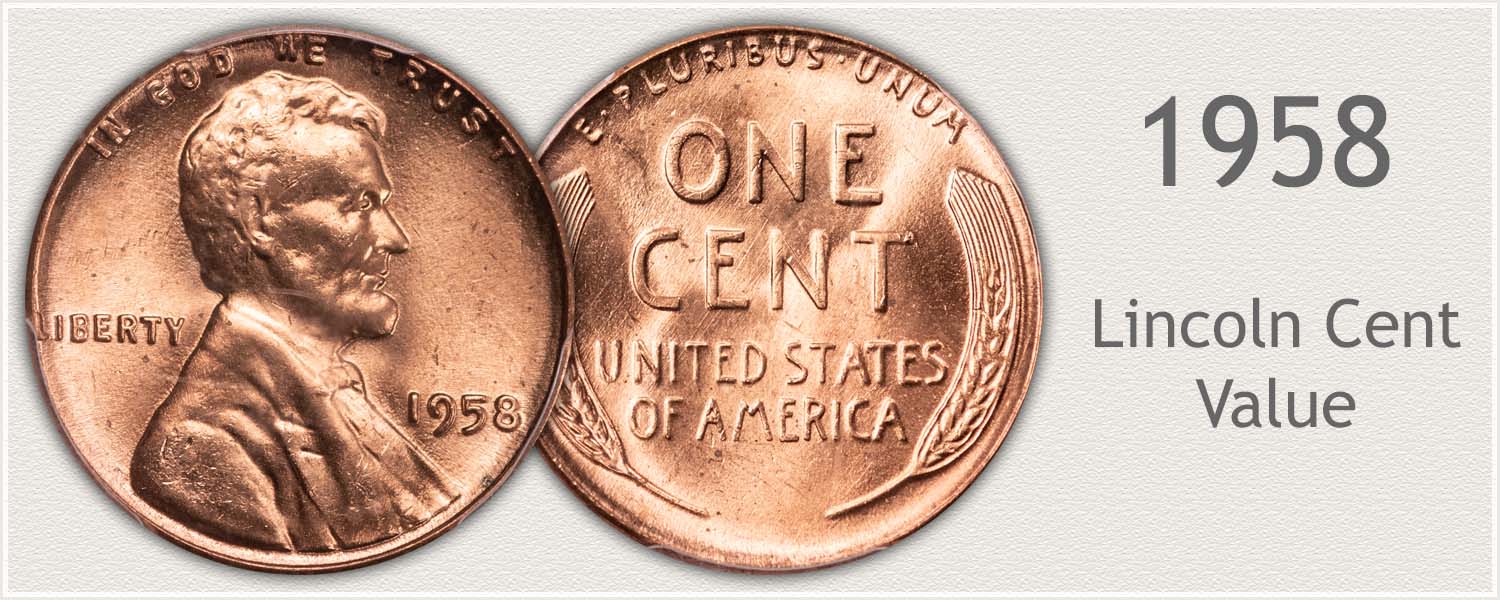
Steps Leading to Value:
- Step 1: Date and Mintmark Variety – Identify each date and its mintmark variety.
- Step 2: Grading Condition – Judge condition to determine grade.
- Step 3: Special Qualities – Certain elements either enhance or detract from value.
| 1958 Lincoln Penny Value | ||||
|---|---|---|---|---|
| Condition of Coin | ||||
| Date | Good | Fine | Extremely Fine | Uncirculated |
| 1958 Lincoln Penny Value Up-Dated | 2025 | |||
| 1958 | $0.02 | $0.02 | $0.03 | $0.58 |
| 1958 D | $0.02 | $0.02 | $0.03 | $0.58 |
Exact position on the value chart involves key elements. Date | Mint Mark | Condition
Collectors first consider the date and mint mark combination of wheat pennies. A process of comparing your coin to images confirms each variety and range of condition.
Condition is judged next. Stages of wear occur over time as a coin passes through commerce. Grading a coin determines extent of wear when compared to a standard. Images in the grading section help visualize these different grades.
Step 1: | Date and Mintmark Combination
Identify Listing of 1958 Penny
A 1958 penny is always in demand; it holds the title as the "final year" of the wheat design. In all, 1,053,478,300 were struck of the two varieties combined.
1958 Lincoln Penny
No Mintmark Under Date: Philadelphia Mint Struck the Coin
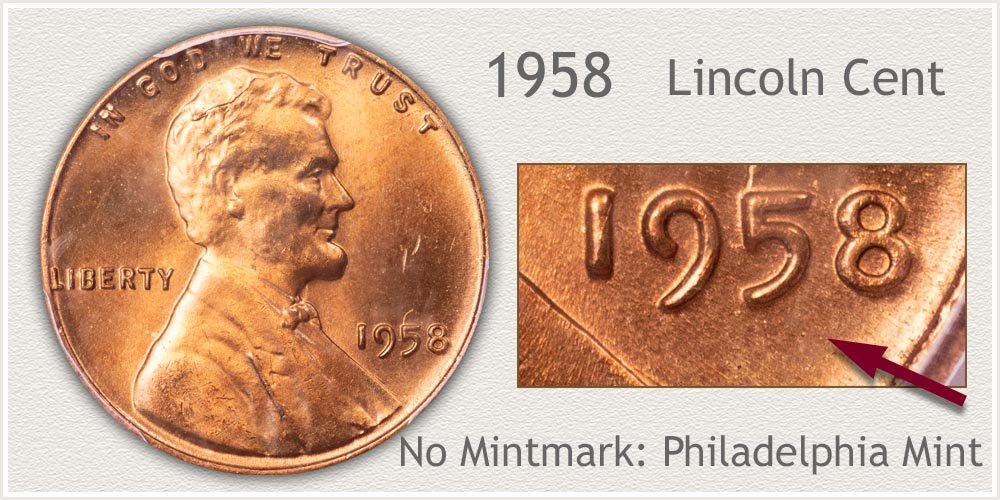
Philadelphia variety 1958 pennies are Abundant on the rarity scale. With a change in design the following year, these "old" design cents were saved from circulation. Many formed the beginnings of a wheat penny collection.
A preferred condition to collectors are Mint State pieces. These are affordable with many still bright as freshly minted. A circulated 1958 penny with just traces of wear is above average.
1958-D Lincoln Penny
"D" Mintmark Under Date: Denver Mint Struck the Coin
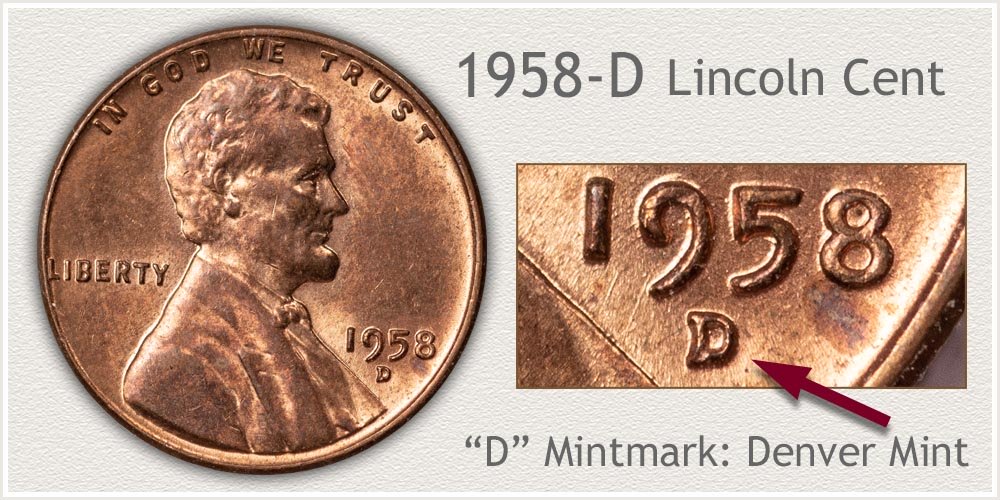
Denver struck 800,953,000 of the 1958 "D" mint variety wheat cents. Large supplies remain due saving at the time because of its end of design status. Rated as Abundant on the rarity scale.
A 1958-D penny in mint state condition - no wear to the surface - is sought by collectors. These high condition coins are affordable and popular with both advanced and beginning collections. Circulated coins retaining strong detail on the reverse wheat stalks are in demand when assembling a circulated set.
Step 2: | Judge Condition to Identify Grade
Collectible Grades Define 1958 Penny Value
Value differences listed on the chart reflect the condition - grade of the coin. Amount of wear to the surface is judged and compared to the images and descriptions. Collector quality is identified using images and descriptions.
Review the uncirculated example image first, it gives a good illustration of the complete amount of original detail on a coin without any wear to the surface.
Work over a soft surface. When viewing, tilt the coin under a single light source helping bring out subtle details.
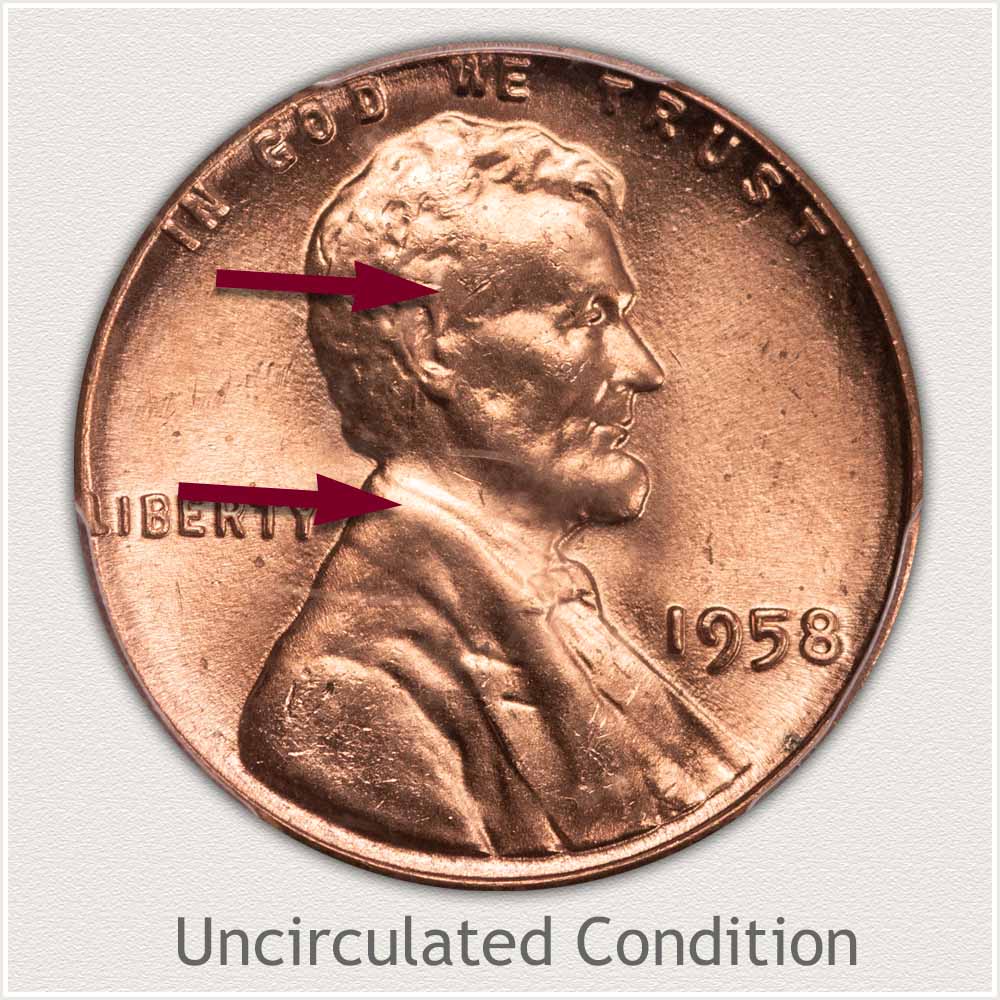
Uncirculated Grade: Many Lincoln cent collectors strive to assemble a stunning display of Mint State - Uncirculated pennies. A 1958 penny is among the second era and affordable in high grade. Key to the condition of these mint state coins is intact luster and no wear to the surface.
Qualifying as uncirculated grade, complete coverage of luster remains on the example penny. Luster is delicate, easily removed, and used to judge presence of wear. Inspect Lincoln's cheek and jaw line first, these areas are prone to circulation contact along with his hair above the temple. Next, starting at the collar, follow the coat line down confirming texture of the metal matches surrounding areas.
Strong details of Lincoln and lettering are noted on this 1958 wheat cent. Brightness of luster is complete, complementing the design. A visually attractive last year of issue wheat penny.
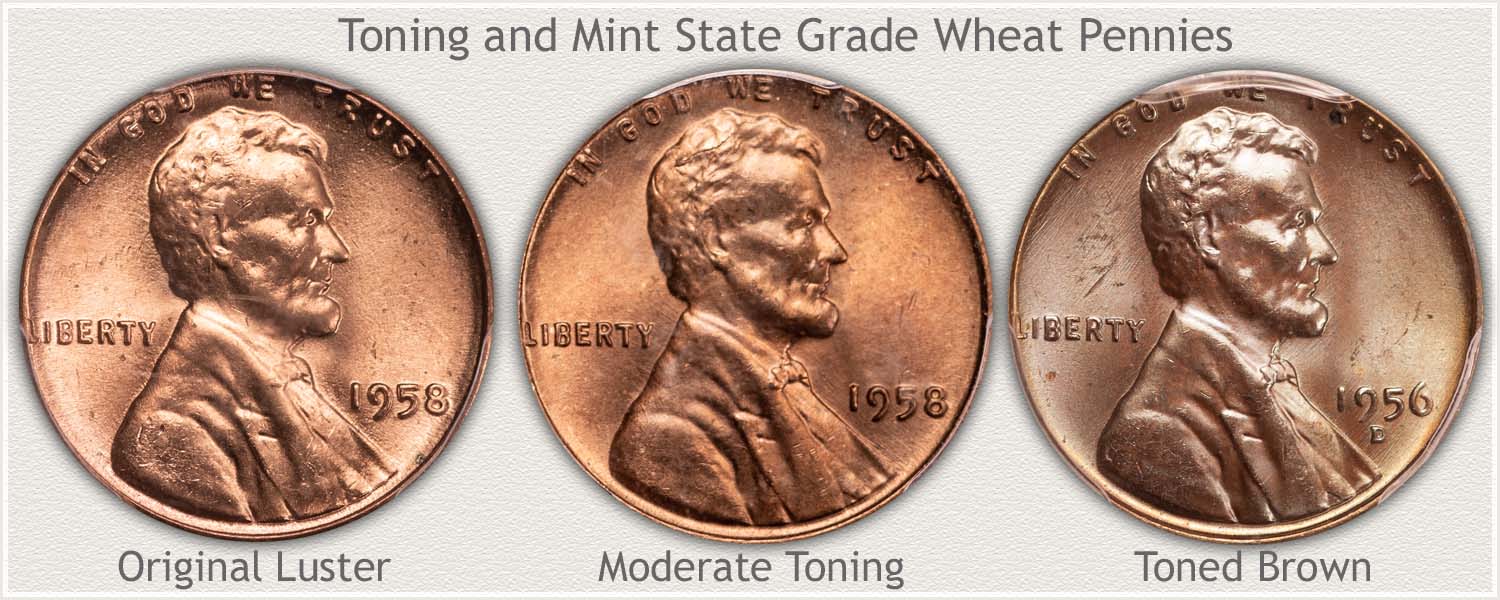
Evaluate Toning of 1958 Penny: Viewing a group of mint state pennies shows the various colors and toning possibilities. Time and level of protection determines the depth of toning. Importantly, wear - removal of metal - is not indicated by toning. Judgement of toning applies to aesthetics value.
First in line is the bright luster 1958 cent, very little toning has occurred. Notice the slight warming of color on the center 1958 cent. Moderate toning is beginning to form on the high points and fields. A mostly brown color is displayed to the far-right coin. Looking closely at all examples, Lincoln's jaw line and cheek are without wear. His coat line separating the shirt remains with original texture.
These examples show Mint state - uncirculated cents are found with a range of toning. A range of value is also found among toned to bright wheat cents. When considering adding a coin to a set, collectors develop personal preferences of toning. In broad terms, pleasing, original, bright luster is valued high. Toning, in any stage, either enhances or detracts. The central coin is notable by the evenly distributed colors. Generally, an uncirculated wheat cent toned brown is lower in value.
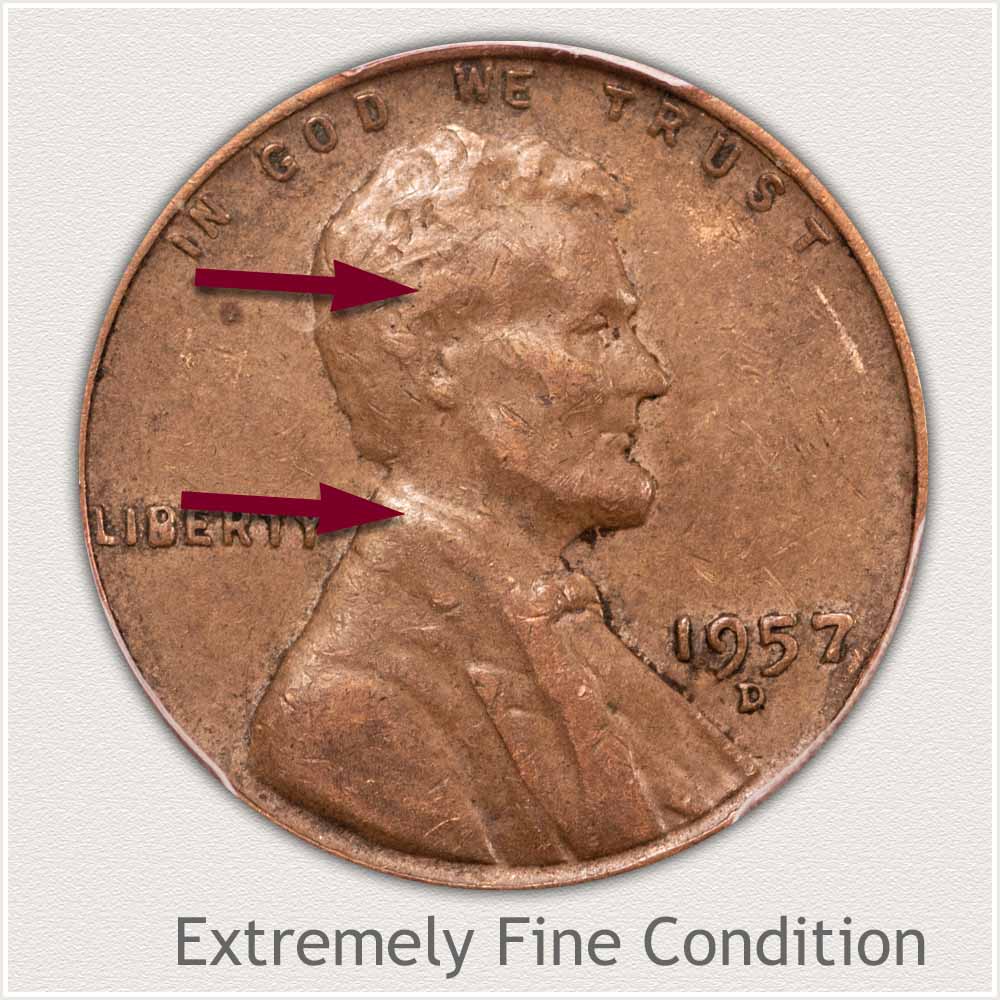
Extremely Fine Grade: Just a short time in circulation results in small areas of flatness beginning to appear on the overall design. Light noticeable wear is an indication of the Extremely Fine grade.
Hair above and behind the temple is slightly flattened to the upper most parts. Waves of hair remain separated with a small merged spot above the ear. Cheek and jaw are smooth in texture on highest points and noticeable smoothness follows the coat line from collar to shirt. These areas; temple, cheek, jaw, and coat line remain rounded with just a touch of flatness, confirming the extremely fine grade.
With a detailed portrait of Lincoln remaining, lightly circulated wheat cents are affordable and sought by young and beginning collectors. Further appeal of this coin is a lack of distracting marks. Toning in shades of soft tans and browns are undisturbed.
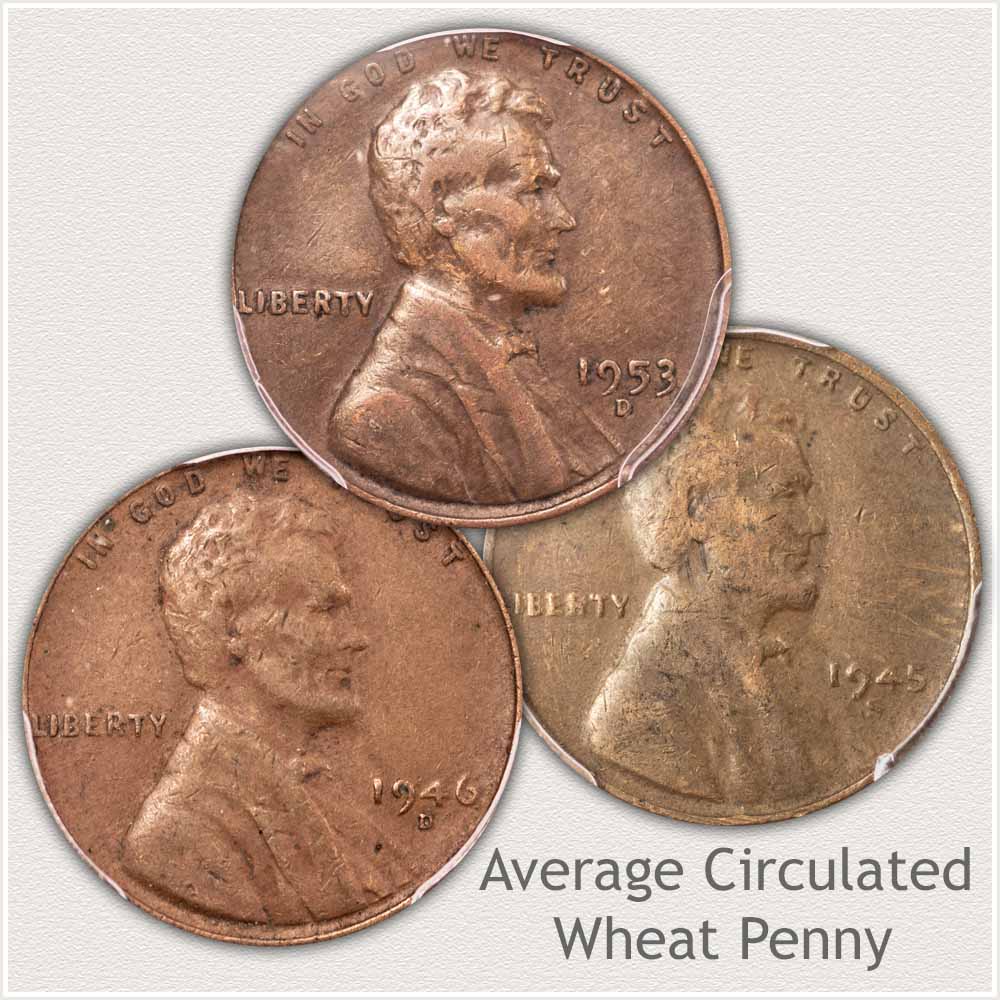
Average Circulated Condition: Wheat pennies showing moderate to heavy wear are available in quantities. Saved from circulation as the wheat design was retired, many dated in the 1950's remain today. These circulated coins form the base value to wheat cents.
Worn past the acceptable stage of extremely fine, an average circulated coin displays wear flattening many of the bold features of Lincoln. His hair is now connected to the temple. Notably, flat areas cover the cheek and jaw. Loss of high-profile elements is distinct.
Each of the coins display a nice natural brown toning, an important positive. Note also a lack of large marks, any distractions would reduce market acceptance.
Video | Grading Lincoln Wheat Pennies
Detecting wear and condition by examining all parts of the coin's surface confirms a grade.
Grading Lincoln Wheat Pennies covers the grading process in detail. Additional images and descriptions identify subtle points to grading.
Step 3: | Special Qualities Enhancing Value
1958 Last Year of Issue | Always in Demand
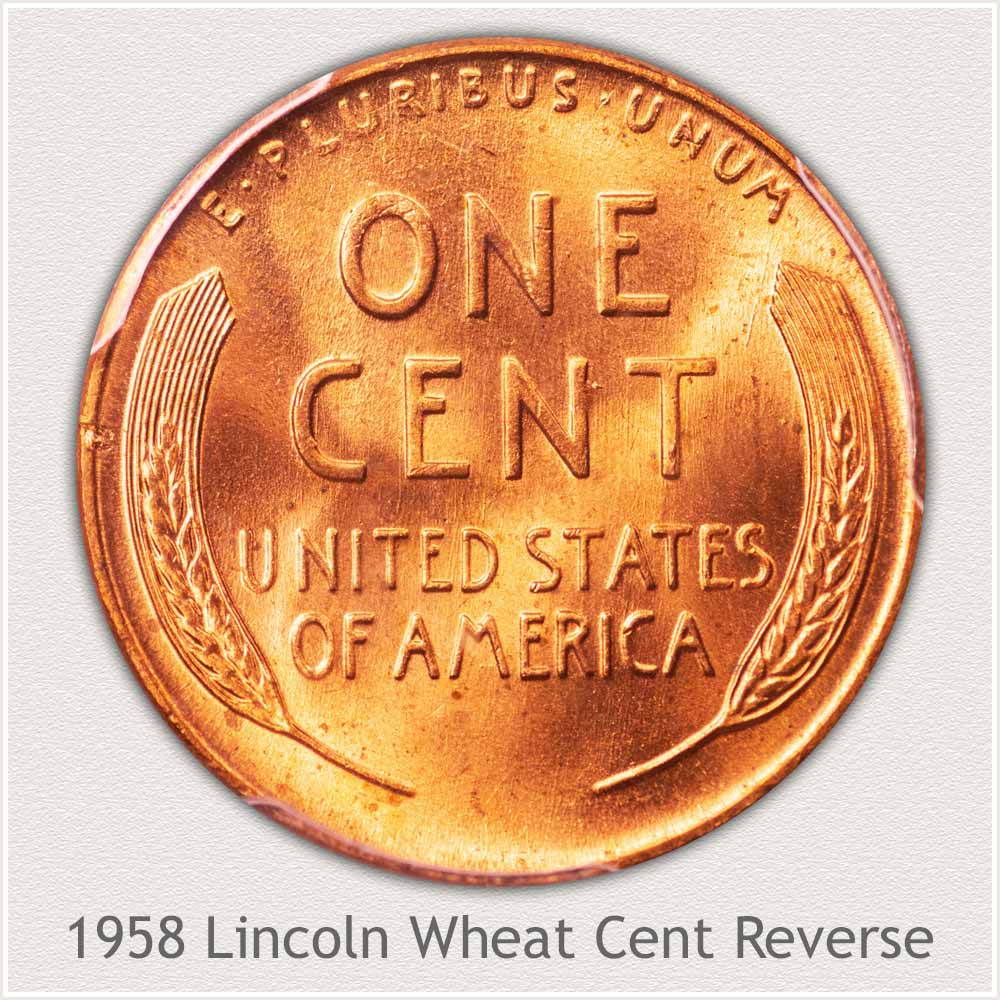
Collecting coins by themes drive values. Interesting ways of assembling collections takes many forms, all placing demand on these old wheat pennies. Included in most Lincoln wheat collections is a 1958 penny. Two stylized wheat stalks are featured on the reverse design lending themselves to the wheat penny name.
A complete date and mintmark collection of wheat cents spanning 1909 to 1958 is tops in popularity. Additionally, dividing the series into eras is also popular. The long running wheat series is often separated 1909 through 1933 as a challenging collection of the early years. 1934 to 1958 representing latter years, forms an affordable collecting theme.
Variety and design type collections are also themes pursued by collectors. A type collection including 1909 | 1943 | 1958 cents represents important eras (first of and last of) and alloy types of wheat pennies.
A themed collection featuring different mints striking wheat cents is enhanced by the 1958-D Denver cent whose production was the last year of the series. 1958 fits nicely in many sets.
A recap of the wheat penny series 1909 to 1958 saw mintage totals of all varieties amounting to 25,787,656,675 coins. Philadelphia represents 14,001,287,771 pennies of the total. Denver struck 9,030,527,900 and San Francisco minted 2,755,841,004. A 1958 Wheat penny represents an iconic US coin.
ReferencesUS Mint. 1958 US Mint Annual Report https://hdl.handle.net/2027/pst.000068053482
Coin Values | CoinStudy Articles
Lincoln Wheat cents span the years 1909 through 1958. From the top condition coins collected by advanced collectors to worn examples; to an affordable collection for young collectors, the range of value is extensive. Identify your date, mint and condition and refer to the value chart.
Coin series enjoy different levels of popularity within the hobby. Lincoln cents are avidly collected and pursued. Values are directly related to their interest by collectors. Knowing a coin is in demand by many is an understanding into your coins.
Printable sheet to list and inventory your coins.
★ Coin Values Discovery finds 1958 Penny Value and...
All US coin values. Recognize your old coins using the image links leading to value charts. Date | Mintmark | Condition are considered; all described and imaged within each series. Surprising value is often found in the smallest of detail.